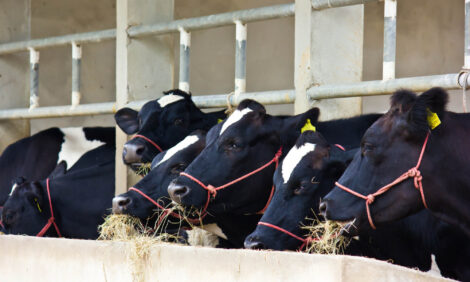



Weekly global protein digest: Trump Administration announces actions, France bans cattle exports
Analyst Jim Wyckoff shares an update on global protein news
Trump Administration announces actions to strengthen U.S. beef industry
USDA issued a press release Wednesday afternoon, announcing “a suite of actions to strengthen the American beef industry, reinforcing and prioritizing the American rancher’s critical role in the national security of the United States. Since 2017, the United States has lost over 17% of family farms, more than 100,000 operations over the last decade. The national herd is at a 75-year low while consumer demand for beef has grown 9% over the past decade. Because increasing the size of the domestic herd takes time, the U.S. Department of Agriculture (USDA) is investing now to make these markets less volatile for ranchers over the long term and more affordable for consumers…. Today, USDA will immediately expedite deregulatory reforms, boost processing capacity, including getting more locally raised beef into schools, and working across the government to fix longstanding common-sense barriers for ranchers like outdated grazing restrictions,” said the USDA press release. Click here for details of the plan.
Report: Trump administration looking to increase Argentine beef imports 4X
The White House is looking to buy four times its typical quota of Argentine beef in an effort to lower U.S. consumer beef prices — a move that risks alienating longtime farm-state allies of President Trump, according to people familiar with the talks and reported by Politico. Trump administration officials have told congressional Republicans and agriculture industry representatives that they’re eyeing a purchase of 80,000 metric tons of Argentine beef, though that number is not final and talks are ongoing, according to the four people and one senior administration official, who were all granted anonymity to discuss the matter, said Politico. The U.S.’ current beef import quota on Argentina is 20,000 metric tons. Republican senators like Sen. Tommy Tuberville (R-Ala.) and Sen. Joni Ernst (R-Iowa) launched a flurry of calls on Tuesday to USDA Secretary Rollins, U.S. Trade Representative Jamieson Greer and Trump himself, expressing their deep concerns with bringing in more Argentine beef. “Some of them pushed for a full reversal of Trump’s suggestion, and others left with the impression they would have time to brainstorm alternative ways to lower U.S. beef prices for consumers before the president made a new deal that could hurt American producers. ‘Bottom line: if the goal is addressing beef prices at the grocery store, this isn’t the way,’ Sen. Deb Fischer (R-Neb.) said in a statement earlier this week,” reported Politico.
NCBA pushes back on Trump social media post
The National Cattlemen’s Beef Association issued a press release Wednesday that did not reference President Trump’s social media post . However, NCBA CEO Colin Woodall said, “The National Cattlemen’s Beef Association and its members cannot stand behind the President while he undercuts the future of family farmers and ranchers by importing Argentinian beef in an attempt to influence prices. It is imperative that President Trump and Secretary of Agriculture Brooke Rollins let the cattle markets work.”
Trump Claims Tariffs Made Ranchers Prosper, but Economists Say the Picture Is More Complex
Fact-checkers find partial truth in Trump’s statement linking cattle industry gains solely to his trade policies
President Donald Trump took to Truth Social today to argue that U.S. cattle ranchers owe their recent success to his trade actions.
Trump on Truth Social said: “The Cattle Ranchers, who I love, don’t understand that the only reason they are doing so well, for the first time in decades, is because I put Tariffs on cattle coming into the United States, including a 50% Tariff on Brazil. If it weren’t for me, they would be doing just as they’ve done for the past 20 years — Terrible! It would be nice if they would understand that, but they also have to get their prices down, because the consumer is a very big factor in my thinking, also!”
Trump’s claim blends elements of truth with overstatement. It’s accurate that his administration imposed a 50% tariff on certain Brazilian agricultural imports, including beef. Those tariffs were framed as a move to bolster U.S. producers and reduce reliance on foreign suppliers.
However, economists note that the cattle sector’s profitability this year stems primarily from a historically small U.S. herd, the lowest since the early 1950s, following years of drought and high feed costs. These tight supplies have pushed cattle and beef prices higher, benefiting ranchers independently of tariff policy.
While tariffs can support domestic producers by curbing competition, analysts emphasize that such measures typically raise prices for consumers rather than lower them, contradicting Trump’s suggestion that tariffs help reduce costs at the grocery store.
Bottom Line: Trump’s tariffs have played some role in shaping market conditions, but they are far from the sole reason ranchers are “doing so well.” The broader story includes weather, supply constraints, and strong beef demand — not just trade policy.
France bans cattle exports and bullfighting as lumpy skin virus spreads
Government imposes emergency curbs as first major outbreak hits French farms
France has imposed a sweeping ban on cattle exports and events involving livestock, including bullfighting, as authorities race to contain the spread of lumpy skin disease — a highly contagious virus infecting the country’s herds for the first time, Reuters reported.
The French agriculture ministry said Friday that the measures will take effect on Oct. 18 and remain in place until Nov. 4, with the possibility of lifting them if conditions improve. Lumpy skin disease, spread by insects, affects cattle and buffalo, causing painful blisters and reduced milk production. While the virus poses no threat to humans, it frequently triggers trade restrictions and severe economic losses, according to Reuters. “The very recent emergence of several isolated outbreaks — one in Ain, three in Jura, and three in Occitanie — is a cause for concern and is probably the result of animal movements, some of which were illegal,” the ministry said.
After slowing during the summer, new outbreaks have surged this month, spreading from the Alps to the Jura and Ain regions in eastern France. Three more clusters were discovered this week near the Spanish border.
During a visit to Jura, Agriculture Minister Annie Genevard cautioned that “the future of French livestock farming is at stake.” She added, “We are at a critical moment. It is essential we keep up our efforts to protect the French cattle herd. Let’s rise to the challenge together, as we have since last June.”
The virus, long endemic in Africa and the Middle East, was absent from Western Europe until mid-2024, when outbreaks first occurred on Italy’s Sardinia Island, followed by France. Spain reported its first case last week.
Infections appeared recently in three communes in the Pyrenees-Orientales — La Bastide, Oms, and Valmanya — about 30 kilometers from the Spanish border, prompting a mandatory vaccination campaign in nearby areas. “We can imagine that there is a link with Spain, but we are still investigating,” Genevard said, according to Reuters.
The French government called the situation a critical test for its animal-health system, stressing that the swift containment of the virus is essential to protect the nation’s beef and dairy industries from longer-term disruption.
USDA reports no new screwworm cases along border as monitoring intensifies
Secretary Rollins says over 22,000 specimens tested with zero U.S. detections; 100 million sterile flies released weekly in Mexico as new Moore Air Base facility nears completion
USDA Secretary Brooke Rollins said no new cases of New World Screwworm (NWS) have been detected in the past week in Mexican states bordering the United States, marking a positive milestone in containment efforts. In a post on X, Rollins detailed that USDA recently convened a call with more than 200 stakeholders to unveil the USDA NWS Response Playbook, which outlines the agency’s current surveillance and contingency strategies should the pest cross into U.S. territory.
Rollins said USDA teams are actively monitoring 350 collection sites in NWS-affected areas of Mexico, while in the U.S. the agency is maintaining 113 NWS-specific fly traps across ten counties in three states, supplemented by 7,300 fruit fly traps. “To date, 22,210 specimens have been tested (1,756 in the past week) resulting in ZERO detections in the US,” Rollins reported.
To suppress the pest population, USDA is releasing 100 million sterile flies each week via more than 40 dispersal flights over southern Mexico. Inspectors have also examined 1,670 wild or feral animals for signs of NWS in Texas. While 7,885 cases have been confirmed in southern Mexico—a rise of 838 since October 2—there have been no detections in border states since October 5.
Rollins noted that the new Moore Air Base facility, slated to open in early 2026, will expand capacity to disperse 300 million sterile flies weekly along the U.S.-Mexico border. Her latest update, while focused on progress and prevention, notably avoided previous criticisms of Mexico’s handling of the NWS outbreak.
Beyond Meat’s Last Stand: Debt Deal Wipes Out Shareholders as Stock Plummets Below $1
The onetime Wall Street darling that symbolized the future of food is now fighting for survival after a massive debt-for-equity swap crushed investor value
Beyond Meat’s stock collapsed this week to near $1 a share — a stunning reversal for a company once valued at over $14 billion. The plunge came after the embattled plant-based meat maker finalized a debt exchange that handed bondholders hundreds of millions of new shares, effectively wiping out most existing investors.
Shares fell almost 50% on Monday to about $1.10 and hovered between $1.03 and $1.10 on Tuesday, leaving the stock down more than 76% this year and deep in penny-stock territory. As of now, the shares are trading around $0.60, down about 10.46% intraday. In 2019, shares had soared near $240 following the company’s high-profile IPO, fueled by investor enthusiasm for a “meatless revolution.” Since then, Beyond has lost over 99% of its peak value.
A Debt Deal That Saved the Company — but Not Its Shareholders
As Reuters reported, the restructuring swapped Beyond Meat’s existing 2027 convertible bonds for new 7 percent convertible notes due 2030, along with hundreds of millions of shares. The move is designed to reduce about $800 million in debt and extend maturities — but it came at a massive cost to common shareholders, who now face dilution estimated at over 300–400 percent. “The exchange buys time, but at the price of obliterating shareholder equity,” one analyst told Reuters.
The move was effectively a survival maneuver. Beyond’s balance sheet had been under severe strain, with more than $1.3 billion in debt and persistent operating losses. The company has also been burning through cash, struggling to regain profitability amid weakening demand.
The Great Fade of the Plant-Based Boom
Beyond Meat’s collapse underscores the dramatic cooling of the plant-based food sector. According to AP News, the company’s U.S. sales have declined steadily over the past two years as consumer enthusiasm waned. Shoppers have balked at high prices and “processed” ingredient lists, while inflation has driven many back to cheaper animal protein.
“The promise of saving the planet wasn’t enough to overcome the reality of taste and price,” wrote one analyst on Investing.com, noting that many early adopters of Beyond Meat products have not returned. Once hailed as a disruptor, Beyond now finds itself fighting for relevance in a crowded, contracting market.
Broader Lessons for Investors
The company’s fall from grace serves as a cautionary tale about debt-fueled growth in the absence of sustainable fundamentals. Analysts warn that Beyond’s situation reflects the perils of overreliance on hype and capital markets. “Convertible debt can work when equity is rising,” one market strategist told Financial Times. “When it falls, it becomes a trapdoor.”
With shares below $1, Beyond risks delisting from Nasdaq if it fails to regain compliance in the coming months. For existing shareholders, recovery appears unlikely unless the company can dramatically cut costs, revive consumer interest, and prove that plant-based meat can still be profitable.
Bottom Line: Whether Beyond Meat can reinvent itself — or becomes another symbol of post-pandemic excess — now depends on its ability to execute a turnaround in a market that has largely moved on.
Weekly USDA dairy report
CME GROUP CASH MARKETS (10/17) BUTTER: Grade AA closed at $1.5950. The weekly average for Grade AA is $1.6305 (-0.0135). CHEESE: Barrels closed at $1.7700 and 40# blocks at $1.7750. The weekly average for barrels is $1.7400 (N.C.) and blocks $1.7255 (-0.0110). NONFAT DRY MILK: Grade A closed at $1.1100. The weekly average for Grade A is $1.1195 (-0.0250). DRY WHEY: Extra grade dry whey closed at $0.6550. The weekly average for dry whey is $0.6380 (+0.0070).
BUTTER HIGHLIGHTS: Domestic butter demand is reported as light in the Central region, steady in the West region, and somewhat stronger in the East region. Demand from international buyers is strong. Plenty of cream continues to be available with fat levels in milk output seasonally increasing. For many butter manufacturers, contractual cream intakes are filling their needs, making for light spot cream demand from butter makers. Butter production schedules vary from steady to strong. Both salted and unsalted butter loads of 80 percent butterfat butter are available. Loads of 82 percent butterfat butter are somewhat tight due to export demand. Bulk butter overages range from 2 cents below to 5 cents above market across all regions.
CHEESE HIGHLIGHTS: Cheese markets in the East remain active as bulk aged cheese sales strengthen. Producers are holding output levels steady, though some plants are limited by maintenance downtime. Spot milk remains available for Class III use, keeping production schedules balanced. Export demand is firm, and inventories are described as stable heading into late October. In the Central region, cheese production eased this week as a few plants underwent maintenance. Spot milk movement stayed steady, while Class I pulls continued to tighten available volumes. Domestic orders held their pace, and export demand continues to provide a solid outlet. Mozzarella interest improved, and inventories are in line with market needs. Across the West, milk supplies are ample enough to support steady cheese production. Manufacturers remain focused on contract fulfillment, with spot loads moving consistently through the region. Domestic sales are steady, and export activity provides meaningful support. Competitive global pricing is making U.S. product less competitive in overseas markets.
FLUID MILK HIGHLIGHTS: Nationwide, milk volumes are steady to stronger, predominantly due to seasonal temperature changes. Milk component output levels are strong, providing ample amounts of cream to the market. Class I demand is strong in most areas. In some cases, milk is being moved across regions to meet bottling demand. Class II production is trending up heading into the holiday season. Demand for extended shelf-life cream and similar products is increasing. Class III production is steady in each region. Many facilities are undergoing scheduled downtime, so there is some milk available for spot purchases. Spot sales ranged from $0.25-under to $2.00-over Class III. Class IV production is also increasing. Some contacts mention butter churns are now operating seven days a week to meet holiday demand. Cream is available for spot purchase in every region. Cream multiples for Class II and Class III use rose in the Central and East regions. Condensed skim production decreased in the East, while other regions reported a steady state. Condensed skim sales activity was lighter this week, but prices were generally higher. Reported sales for condensed skim ranged from flat to $0.15 above Class price. Cream multiples for all Classes range: 1.00 – 1.24 in the East; 1.05 – 1.26 in the Midwest; 0.89 – 1.18 in the West.
DRY PRODUCTS HIGHLIGHTS: Prices for low/medium heat nonfat dry milk (NDM) decreased across the range and mostly price series in the West this week, while holding steady in the Central and East regions. High heat NDM prices decreased in the Central and East regions and at the bottom of the range in the West, but the top of the West region price range pushed higher. The Central and East region price range for dry buttermilk increased at the bottom while the top remained the same. In the West, the bottom of the price range held steady while the top moved lower. Meanwhile, the mostly price series decreased at the bottom, while the top was unchanged. Prices for dry whole milk decreased this week. Dry whey prices increased in the Central and West regions across the ranges and mostly price series. In the Northeast, dry whey prices were unchanged. The bottom of the mostly price series for whey protein concentrate 34% was unchanged, but the top of the mostly price series and both ends of the price range moved lower. Lactose prices remained the same. Prices for acid casein declined this week. The top of the rennet casein price range was unchanged, but prices decreased at the bottom.
ORGANIC DAIRY MARKET NEWS: In the USDA AMS National Organic Program (NOP)'s Organic Insider sent out on October 1st, an update was released regarding the impact of the lapse in appropriations on the Fall 2025 National Organic Standards Board (NOSB) meeting, currently scheduled for November 4-6 in Omaha, NE. Employees for NOP remain furloughed. If they return from furlough before 9:00 AM Eastern on October 22, the NOSB meeting will take place virtually. The Agricultural Marketing Service (AMS) reported August 2025 estimated fluid product sales. The U.S. sale of total organic milk products was 263 million pounds, down 9.4 percent from the previous year. From the start of the year through August, the U.S. sale of total products was 1,987 million pounds, down 1.4 percent compared to the same period last year.
US NATIONAL RETAIL REPORT: Total conventional dairy ads are up 10 percent in the week 42 retail survey, while organic dairy ads are down 23 percent. Cheese is the most advertised conventional dairy commodity. The most advertised organic commodity is milk. Conventional yogurt ads saw the largest percentage growth for commodities that appeared in the previous survey.



